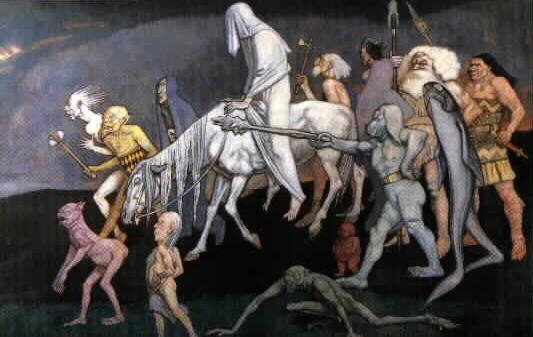
Deep within the realm of Irish mythology lies a race of mysterious beings known as the Fomorians. These legendary creatures have captivated the imaginations of storytellers and historians for centuries. The Fomorians have left an indelible mark on Irish folklore with their intriguing origins, powerful abilities, and mythical connections.
Origins and Appearance
The Fomorians are believed to be a group of supernatural beings who inhabited Ireland in prehistoric times. Their precise origins remain shrouded in myth and legend, making it difficult to ascertain the truth behind their existence. Some accounts suggest that they were descended from the ancient gods, while others claim they emerged from the depths of the sea. Again, I revert back to Atlantis.
Described as formidable and grotesque, the Fomorians were often depicted as monstrous creatures with deformities. Some had a single limb or eye, while others were known for their immense size or unsettling appearance. They were often associated with chaos, darkness, and the ‘untamed’ forces of nature.
Mythical Connections and Interactions
In Irish mythology, the Fomorians interacted with various legendary figures and entities. They were seen as adversaries of the Tuatha Dé Danann, another powerful supernatural race associated with the early inhabitants of Ireland. The Fomorians were often depicted as tyrannical rulers, imposing their dominance over the land and sea.
Despite their formidable reputation, some Fomorians displayed complex characteristics. For instance, Balor of the Evil Eye was a notable Fomorian king with a deadly eye capable of wreaking havoc and destruction. The ‘evil eye’ can be seen worldwide, even today.
However, not all Fomorians were malevolent. Figures like Bres and Elatha were described as noble and wise, displaying qualities that deviated from the general image associated with their kind.
Symbolism and Interpretations
The Fomorians served as powerful symbols in Irish mythology, representing nature’s chaotic and untamed aspects. They were associated with the forces that stood in opposition to order, harmony, and civilization. In this sense, the conflicts between the Fomorians and the Tuatha Dé Danann symbolized the eternal struggle between chaos and order, good and evil.
Some scholars interpret the Fomorians as metaphors for the challenges faced by early Irish societies, such as invasions, famine, and natural disasters. They may have represented external threats or internal struggles, providing a mythological lens through which these difficulties could be understood and confronted.
Legacy and Influence
The Fomorians continue to exert their influence in modern culture, captivating the interest of artists, writers, and mythology enthusiasts. Their tales have been retold and reimagined in various forms, including literature, art, and music. Their imagery often appears in contemporary fantasy works, connecting the ancient mythology of Ireland with modern storytelling.
Conclusion
The Fomorians stand as intriguing figures within the realm of Irish mythology. As mythical beings associated with chaos, darkness, and the untamed forces of nature, they have left an enduring mark on the cultural heritage of Ireland. Their legends and symbolism continue to inspire curiosity and ignite the imagination. By delving into the mysteries surrounding the Fomorians, we gain a deeper appreciation for the rich tapestry of folklore that has shaped our understanding of the ancient world.